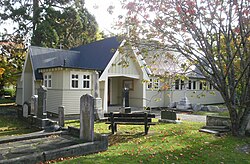
The Reverend Frederick Thatcher (5 September 1814 – 19 October 1890) was an English and New Zealand architect and clergyman.
Frederick Thatcher was born in Hastings, Sussex, England, 5 September 1814. Thatcher's mother was landed, his father was a riding officer.[1][2] At 16 years old Thatcher articled to a London architect, Alfred Bartholomew. Six years later Thatcher established his own architectural and surveying practice. In 1836 Thatcher became an associate member of the Institute of British Architects of London.[1]
Thatcher married Elizabeth Watt on 30 June 1840 but she and an infant son died in 1842.[2][1] After the deaths of his wife and son, Thatcher purchased rural land near New Plymouth from the New Zealand Company. With his brother-in-law Isaac Newton Watt, he left England in 1843 aboard the barque Himalaya and arrived in New Plymouth on 23 December 1843.[1][2]
In New Plymouth Thatcher became associated with George Selwyn, the Bishop of New Zealand, and engaged in architectural work.[1] In 1845 Thatcher left for Auckland where he became superintendent of public works and a lieutenant in the Auckland Militia. He served as Sir George Grey's secretary from 1846 until 1848 when he enrolled in St John's College, Auckland.[1][2] On 6 November 1849, at St Mary's, Taranaki, he married Caroline Wright. Thatcher remained at St John's College until 1853 when he was ordained as a priest.[1] Thatcher was appointed vicar of St Matthew's parish in Auckland and retired from the position in 1856 on account of ailing health and returned to England with his family.[1][2]
In England Thatcher was working as a curate in Northamptonshire.[1] On 14 August 1861 Thatcher had returned to New Zealand with his family. Bishop Selwyn appointed him vicar of St Paul's Church, Thorndon. As vicar he was the architect for the design of St Paul's Cathedral.[1][2] Thatcher resigned from the parish due to poor health and on 25 October 1864 went to Auckland to work as Governor George Grey's secretary again. When Grey's term as governor ended in 1868 Thatcher returned to England to be with his wife and son.[2]
After Thatcher's return to England he worked as secretary to the Bishop of Lichfield, which at the time was held by Selwyn. Following Selwyn's death Thatcher assisted Charles Abraham with founding Selwyn College, Cambridge. Afterwards, from 1883, he was prebendary of Lichfield Cathedral.[2]
Thatcher died on 19 October 1890 at Bakewell, Derbyshire. Thatcher was buried at Lichfield Cathedral near Selwyn's grave.[2]
Thatcher mostly designed churches, although he did work on Mansion House for George Grey.[1] Thatcher's ecclesiastical designs were in the Gothic Revival style and he assisted Bishop Selwyn in designing the Selwyn churches.[1][3][2] In addition to his work on St Paul's Cathedral Thatcher also designed St John's Church, Trentham as well as 6 other churches during his time as vicar of St Paul's.[1] Other notable works from Thatcher include St. Mary's Church, New Plymouth, The Gables, Christ Church, Nelson, and St. Mary's Church, Parnell, Kinder House, and Selwyn Court.[3][2]
| Name | Date | Image | Note | Ref |
|---|---|---|---|---|
| Workhouse | 1840 |  |
The workhouse became a hospital in 1948, private residence since 1990. Located in Battle, East Sussex | [4] |
| Taranaki Cathedral | 1846 |  |
Registered as a category 1 building with Heritage New Zealand | [5] |
| Auckland Colonial Hospital | 1847 |  |
Demolished | [3] |
| The Gables Colonial Hospital | 1848 |  |
Registered as a category 1 building with Heritage New Zealand | [6] |
| Christ Church, Nelson | 1851 |  |
Demolished | [3] |
| St Matthews Church | 1853 |  |
Building on left. Demolished | [3][7] |
| Kinder House | 1857 |  |
Registered as a category 1 building with Heritage New Zealand | [8] |
| St Stephen's Chapel, Auckland | 1857 |  |
Registered as a category 1 building with Heritage New Zealand | [9] |
| St Mary's Church, Parnell | 1860 | Demolished | [3] | |
| Selwyn Library | 1861 |  |
Registered as a category 1 building with Heritage New Zealand | [10] |
| Selwyn Court | 1861–1865 |  |
Registered as a category 1 historic place with Heritage New Zealand | [11] |
| St John's Church, Trentham | 1863 |  |
Registered as a category 2 building with Heritage New Zealand | [12] |
| St John's Church, Johnsonville | 1864 | Demolished | [1] | |
| Old St Paul's, Wellington | 1866 |  |
Registered as a category 1 building with Heritage New Zealand | [13] |
| St Peter's Church, Tawa Flat | 1866 | Demolished | [1][14] | |
| Bolton Street Cemetery mortuary chapel | 1866 |  |
Demolished but a replica rebuilt in 1990 | [1][15] |
| St Matthias' Church, Makara | 1867 | Demolished in 1920 | [16][1] | |
| Holy Trinity Church, Ohariu Valley | 1870 |  |
Registered as a category 2 building with Heritage New Zealand | [17] |
| Government House, Wellington | 1865 |  |
Designed an addition for the building | [1] |
| Mansion House, Kawau Island | 1865 |  |
Designed an addition for the building | [1] |
| St Mary's Church, Karori | 1866 |  |
Credited to Thatcher by Heritage New Zealand and Margaret Alington but attributed to Nicholas Marchant by Geoffrey Mew and Adrian Humphris. Demolished in 1925 | [18][1] |
general
This is the start of the #general chat. #general is a chat channel to discuss anything related to the hub.